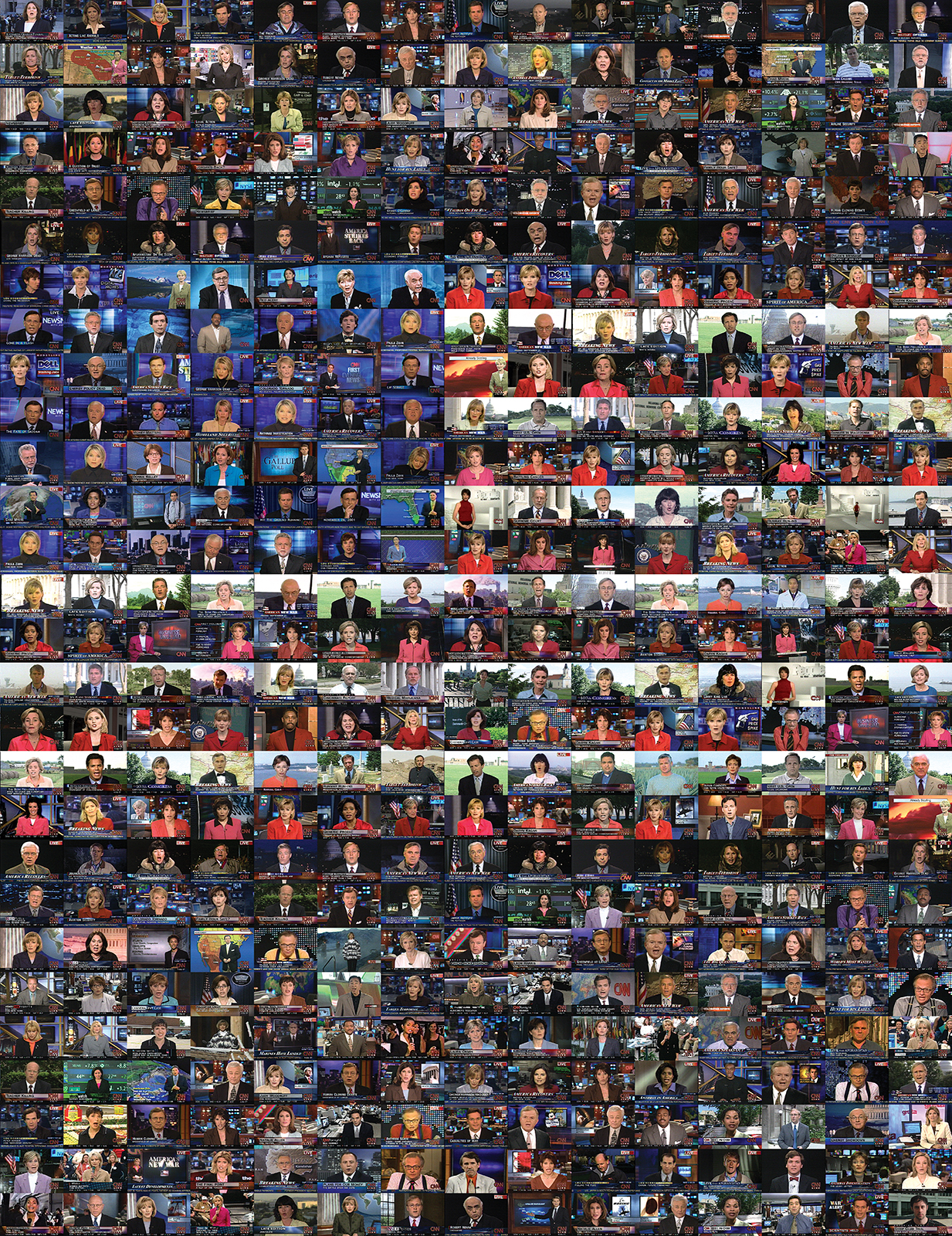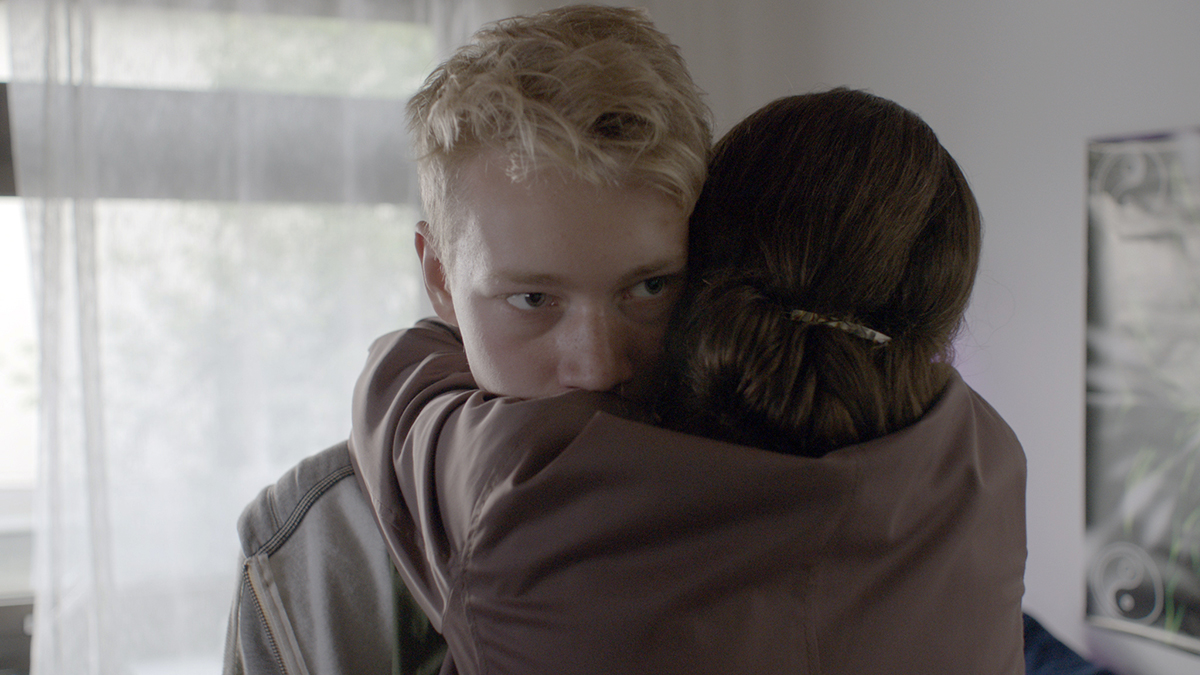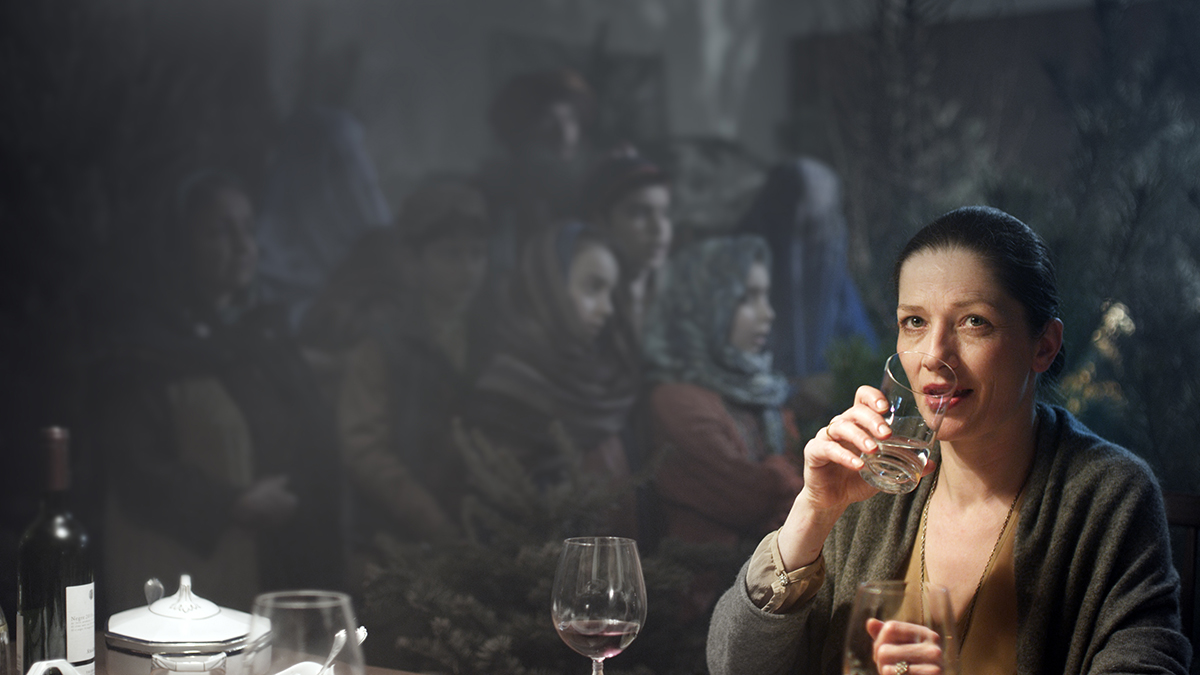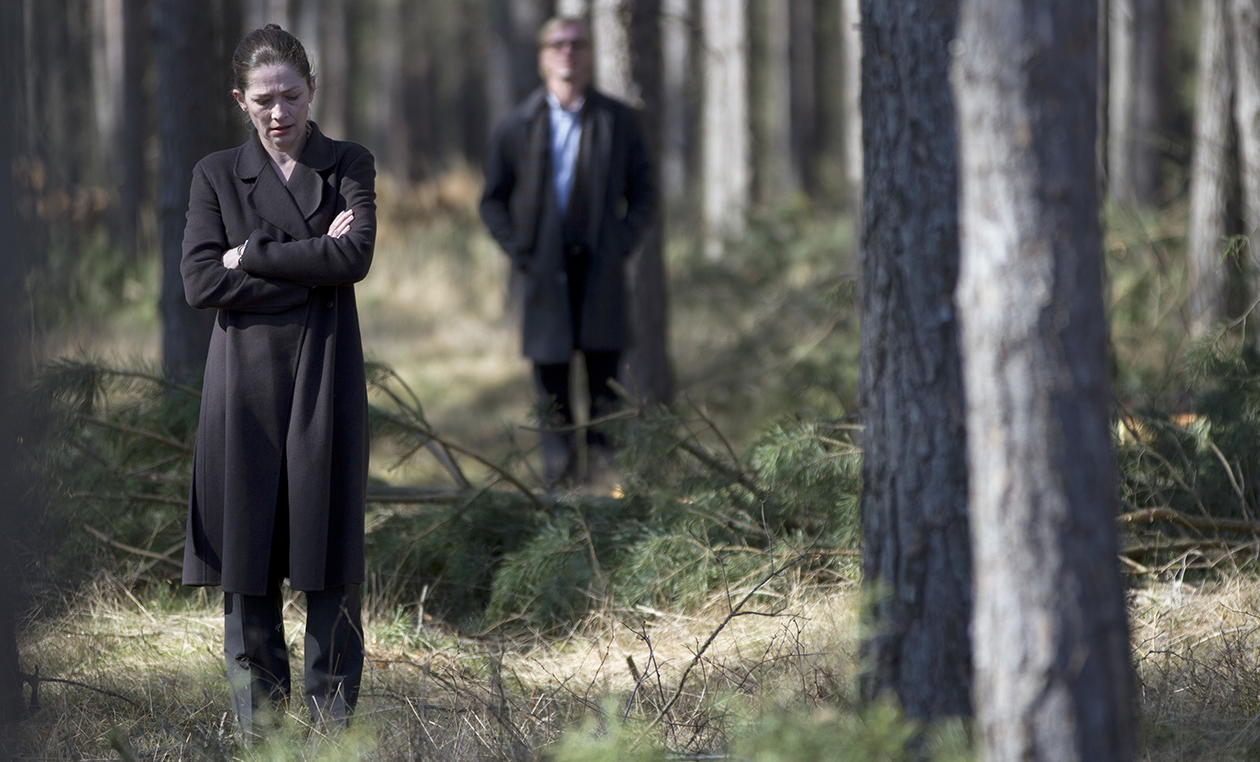Continuity (Diptych), 2012-2015 © Omer Fast
Marina Vinyes Albes : The interview format or the witness testimony is the starting point for many of your films: Spielberg’s List (2003), Godville (2005), The Casting (2007), Looking Pretty for God (2008), Take a Deep Breath (2008), Nostalgia (2009), 5,000 Feet is the Best (2011), Talk Show (2009) … How do you work with these formats and what values do you attach to them?
Omer Fast : I use my work as a pretext to escape from the studio. This brings me into contact with strangers and into the lives of others, which are inevitably more interesting than my own. Like a vampire, I need to meet other people for sustenance. I need to suck out their stories and their language in order to fertilize my own. I see my works as portraits resulting from these encounters – incidentally, very often portraits of workers, whether they’re adult-film performers, funeral directors or drone operators. To paraphrase a famous director, without these real encounters my own fictions would collapse.

Driver I, detail from A Tank Translated, 2002. 4 videos installation, color, without sound. Driver : 9 min 30 s ; Loader ; 4 min 9 s ; Gunner : 13 min 25 s ; Commandert : 5 min 1 s. Courtesy gb agency, Paris, Arratia Beer, Berlin and Dvir Gallery, Tel-Aviv © Omer Fast
MVA : We can notice your interest in the individual’s experience, in particular in demonstrating the gap between this experience and its formalization: the story. In The Casting you put the following words into the mouth of the interviewer: ‘I’m interested basically in the way that the experience is turned into memory and the ways that memories become stories, the ways that memories become mediated…’ We assume that we can consider this sentence as your artistic statement?
OF : That statement you’re quoting from is a complete lie. I wrote it in a hotel room in Texas ten minutes before meeting the soldier I was interviewing and intended it as a last-minute provocation. I wanted to see how he’d react when I stepped out of character and challenged his story, casting doubt on his memories and politics. Inevitably though, with the passage of time, this lie gained more and more traction so that it’s now become the shadow premise of my work. And since I have no more authentic memory of what it is that actually motivated me to make the work, I have to accept that it’s premised on a lie.
MVA : Most of your videos are based on documentary material, which you combine with new fictional elements, always showing the artificial nature of both: the factual and the fictional. However, in your recent works, we find a significant shift in your method: this documentary element disappears and only fiction remains, without the anchoring to the real that used to characterize your practice. How does this step into fiction, this detachment from the real, take place?
OF : I’m not interested in the artificial nature of the stories I’m telling. Quite the contrary, the stories I pick are always marked by the strong belief of the storyteller in what he or she is telling, an identification that is very emotional, even if it turns out that the storyteller is lying. But even if we remove any real-life voice from the work and call it fictional, the work in itself is always a document: it’s a document of wish-fulfilment, as Bill Nichols calls it, but also a historical document of a particular moment in time. And again, I think of my works as portraits. This helps me to elide the fictional and the documentary, the self with an other, since I desperately need both but have faith in neither.

Omer Fast, CNN Concatenated, 2002. Video, color, sound, 18 min. Courtesy gb agency, Paris, Arratia Beer, Berlin and Dvir Gallery, Tel-Aviv © Omer Fast
MVA : Let’s talk about the way you show your work. While the first videos took the form of expanded installations or multi-channel videos, from The Grote Boodschap on they tend to concentrate more and more – with exceptions – on single-channel installations presented in a black box, reproducing the cinematographic classical device.
OF : At some point, I felt that the visual simultaneity offered by multi-screen installation was privileging sensory and spatial experience over temporal processes. Reducing visual input to one screen represents an attempt to focus the works more on the interplay of memory and time. I don’t think it’s a trend though. In the last five years I’ve made two single-screen works and two multi-screen ones.
MVA : What is the audience’s role in all this? I remember Raymond Bellour arguing that installation transforms the viewer into a visitor, and Dominique Païni compares the latter with the figure of the flâneur, with all its implications. Would you agree with that?
OF : The figure of the flâneur strikes me as anachronistic and even impossible given the collapse of space caused by smartphones and the internet. Ideally, I like to think of viewers as detectives or puzzlers. The work is always incomplete prior to their arrival and they need to look at the evidence, establish a chronology, figure out motives, a logic, an interpretive theory for making sense of what’s happened. The crime scene is an appropriate metaphor, not least because of the artist’s inevitable mistakes and omissions, but also because of the deceptive nature of the medium as well as the gaps and distortions involved in any transmission. This leaves the artist with the primary responsibility of covering tracks and making sure the crime scene is perplexing enough to entice questions. One way or another, it has to be a bloody mess.
MVA : So the audience is asked to play an active role vis-à-vis your films. They require indeed an attentive disposition. How do you deal with this and, at the same time, with the fact that the visitor is moving freely all over the space and called upon simultaneously by lots of different stimuli?
OF : I like the open, relatively unruly dynamic that gallery and museum experience involves. The cinema ritual is a little like church where the truth is preached 24 times a second, whereas the gallery functions more like a bazzar or a shopping mall, which I like. To match the logic of the space and the unpredictable movement of viewers, I try to avoid linear storytelling. Instead, I structure my works so that they can be accessible at any time. A looped story can mean that there’s no beginning or ending and no classical narrative arc. Causality and temporality are free to move to the foreground, which creates an alternative to the immersive illusionism of mainstream film. Viewers can come in at any point and develop a subjective understanding of what’s happening in the work, which is highly interpretive and contextual. I’m also interested in processes of defamiliarization, from the uncanny to the Brechtian. These aren’t just critical devices. They’re also seductive hooks meant to entrap viewers. Ideally, I try to create an atmosphere of productive disorientation.

Omer Fast, 5,000 Feet is the Best, 2011. Digital video, color, sound, 30 min. Courtesy gb agency, Paris, Arratia Beer, Berlin and Dvir Gallery, Tel-Aviv © Omer Fast
MVA : Your work plays constantly with the codes of ‘the real’ in film and television, as well as with the reception of those conventions. In this sense, 5,000 Feet is the Best could be seen as a masterclass in them. The mise-en-scène of the principal characters sets in motion an entire series of codes which, from the outset, determine the fictive and the documentary in an almost caricatural manner. Can you tell us about the film in relation to that idea?
OF : My works often have a conversation between two persons as their basis. 5,000 Feet begins with two men talking in a dark bedroom. One of them, we can call him the artist or therapist, is professionally curious and solicitous. The other, let’s call him the pilot or patient, is reluctant and abrasive. The two are somehow stuck together in an unclear but seemingly formal arrangement, which gives the work its initial energy. Who are these two men? Where are they? Who’s paying whom? What are they talking about? Instead of answering these questions, the conversation drifts about and repeatedly stalls over semantics. There’s also a dynamic of power and domination: the patient tries to unmask the therapist, but in doing so he also talks too much and reveals more and more of himself. His talking takes us into other worlds, which appear in colourful flashback and involve impersonation, border-crossing and crime in and around Las Vegas. After each anecdote, the patient abruptly breaks off the conversation and steps out into an empty corridor. It’s only then, when he’s momentarily free and alone, that we hear another voice and the work veers into the documentary and the really surreal. The voice he and we hear belongs to the American military drone operator whom I recorded in a hotel room in Las Vegas in 2010. He talks about his life and work. (People talking about their work is a favourite subject.) Initially, the real drone operator does not appear to share anything with the fictional patient who’s channelling his voice for us – nor with the cock-and-bull stories the latter is telling. But the more he talks and reveals of himself, the more the drone operator’s own crisis appears to be founded on impersonation (not being a ‘real’ pilot, not suffering ‘real’ PTSD), border-crossing (both in real geopolitical and virtual senses) and of course crime (technically called ‘collateral damage’). In doing so, the documentary protagonist of the work is repeatedly anticipated and echoed by his fictional double. And since both subjects appear to be stuck in a crisis, the narrative structure I chose deliberately mirrors their state of mind. It is one that is unresolved and ongoing. Hence the loop.
MVA : With regard to the forms that structure and characterize your work, there is clearly an interest in repetition, as well as in the issue of the double, reconstruction and the loop, although the latter could be considered variations of the former. Can you talk about these concepts in relation to your work?
OF : Doubling is everything for me. I grew up in two countries with two cultures and languages and have never had a fixed unitary identity. My notion of self is completely polluted by the presence of doubles. The trouble I had in early life was feeling that this was unnatural, a temporary dysfunctional state that would eventually be supplanted by the arrival of a much-longed-for, irrevocably authentic, singular self. That never happened and I’ve since revised my expectations a little. In terms of my work though, the notion of the subject as immanently polyvalent, chimeric and forever multiplying is probably the one obsession I can own up to after years of denial. The double, the reconstruction and the loop are just symptoms of this obsession. Artists are bound to repeat themselves. Artists are bound to repeat themselves. Artists are bound to repeat themselves. Repeat.
MVA : And sometimes this repetition turns into simulacra, into a radical repetition where the real is substituted by the sign of the real, a thing without referent – for example in Continuity…
Kierkegaard said that ‘Repetition and recollection are the same movement, except in opposite directions, for what is recollected has been, is repeated backward, whereas genuine repetition is recollected forward.’ Do you agree with that idea? I am thinking particularly of your works Godville and Spielberg’s List…
OF : Having revealed my obsession with doubling, I’m now compelled to add that I’m a boring materialist and don’t actually think genuine, true repetition is possible, at least not as far as human perception is concerned. Time is unbending and linear and each second that goes by is forever lost. If this is so – and we just disappear and our souls evanesce – then any attempt at true repetition must be confined to a symbolic order and represents a perverse wish to buck time, to resist it by a clumsy sleight of hand. And if true repetition is an impossibility, then what we’re left with are shadows: from cave paintings to films, we invest these reflections with a symbolic power that helps us travel in time and communicate with the dead. We see ourselves reflected in pictures and films – even in our children – and tell ourselves that something of us will remain. These images and reflections are our charms, our jujus, our idols and amulets. But they must remain short of being perfect repetitions (or true doubles) or else they won’t be objects of narcissistic pleasure. We can come close to actual cloning but we’re programmed to look for difference and we’ll always find it.
MVA : Your work reveals an interest in evoking groups of individuals who are in some way perceived as outsiders in the community: soldiers – and specifically within the army, the controversial figure of the drone pilot – the refugee, the porno actor, the embalmer… all professions that we do not habitually identify ourselves with. While they share the social space with us, they could be considered intruders due to their particular activities. Why are you interested in portraying these people’s lives and in particular their trade or profession?
OF : I’m not sure I agree. For a very long time in Israeli society, anyone who wasn’t a soldier – anyone who hadn’t done compulsory military service – was more the outsider or intruder. This might not seem or be normal, but even in less outright militaristic societies the notion that soldiers are outsiders is more of a fiction, useful in distancing the citizenry from what soldiers might do in their name. In any event, I think I’m more interested in these figures – soldiers, refugees, adult-film performers, embalmers – because they’re liminal figures invested with special powers (or needs) to cross borders. Soldiers don’t just move across geopolitical borders but also moral and legal ones, where violence is codified and permissible. This special liminal status is also shared by refugees, adult-film performers and embalmers. I keep returning to these subjects because they can report back from these extra-territorial zones where normal behavioural codes no longer apply.

Omer Fast, 5,000 Feet is the Best, 2011. Digital video, color, sound, 30 min. Courtesy gb agency, Paris, Arratia Beer, Berlin and Dvir Gallery, Tel-Aviv © Omer Fast
MVA : Why present 5,000 Feet is Best and Continuity together in the same exhibition? How do you see the relationship between them? What arises from their coexistence in the same exhibition space?
OF : Both of these works deal with trauma. 5,000 Feet looks at trauma in the context of technologization and virtual warfare whereas Continuity looks at how the loss of a child disrupts familial relations. In both works there’s also a strong shared theme of role-playing. The drone operator’s job is defined as much by a mastery of complex technical tasks as it is by a more primitive projection of the operator’s self through the screen and into a distant theatre of combat. As Erving Goffman pointed out, every job involves projection and role-playing: uniforms and formal codes regulate a nurse’s, a waiter’s or a soldier’s perception of self as well as the public’s perception of them. The drone operator is required to put on a flight uniform although his job involves sitting for hours in an air-conditioned container which never leaves the ground. This formal act of dressing-up and make-believe is symptomatic of a central paradox created by the technology which also makes the operator both invulnerable and omnipotent: being an active combatant half-a-world away while carrying on normal domestic life in one’s own neighbourhood. The job of a drone operator involves days and days of surveillance and dreary flight patterns interspersed by moments of extreme urgency, where split-second decisions can impact the lives of both fellow soldiers and innocent civilians. The operator I spoke with claims to be suffering from nightmares, loss of sleep and appetite, as well as anxiety typical of post-traumatic stress disorder. Nevertheless, this self-diagnosis was continually dismissed by people around him, since he’s not deemed to be a ‘real’ combatant and was never at ‘real’ risk. Perhaps in an attempt at self-medication, the operator developed an addiction to role-playing games and flight-simulators, which he played for hours after coming home from his night shifts. Being unable to escape from his nightmare, the traumatized subject goes about reproducing it in a controllable context to the best of his ability. This is exactly the dynamic that’s explored in Continuity. Having lost their child, the parents turn to alternative methods of reproduction, short-circuiting the natural process by inviting strangers into their home and asking them to play family. Lacan defines trauma as an experience that cannot be processed, a rupture in the chain of signification. Both works try to give this rupture a form.
MVA : For your new work, which you have specially created for this exhibition, you decided to film new scenes for Continuity. What was your intention and how do they fit into your previous work?
OF : The original idea was to expand Continuity into a diptych, with the existing work and its sequel being doppelgänger or twinned narratives. Until it is edited and ready I won’t be able to say if that’s really what happened.
MVA : Your ongoing project Spring recreates a lynching in an Arab country involving a hundred performers, giving mobile phones to some of them to record this performance as participants. As you have said, this video was inspired by the circulation of images of Muammar al-Quaddafi’s death in 2011.
You have already dealt with re-enactment in your previous work (in The Casting for instance). Nevertheless, by shooting with mobile phones, this re-enactment involves not only the event but also the medium that makes it visible. How did you come to this idea? What does surprise me is the abolition of the distance between the audience and the film. Since your previous works tend to create a distancing between the visitor and the story being shown, and prevent any passive identification, I wonder what will be the place for the audience in this new piece? It seems as if the visitor would be totally involved in this larger-than-life environment recreating a violent spectacle. Are you working with a script or do you plan to improvise during the shooting?
OF : On the day it happened, I watched Quaddafi’s capture and death on my laptop in Berlin, over and over, jumping between the many mobile phone movies as they were being uploaded. The footage was predictably horrific and banal: its protagonist, alone and stripped of his regalia, could no longer sustain the mythic power his assailants zealously wished to punish him for. He was just a shell, an ageing man with dyed hair begging for mercy. After viewing the fourth different mobile phone movie of the same event, I realized that my attention was shifting away from the one doomed man, whose limp body was only occasionally visible, sometimes at the centre of the image, but more often not. What I was increasingly mesmerized by was the multiplicity of simultaneous images, literally a piecemeal portrait of a swarm descending and consuming someone./p>
The work Spring proposes to recreate this swarm’s-eye-view as a multi-screen installation: the idea would be to create a full-scale performance that achieves the ecstatic dynamic of the real event. Although the performance would not be a specific re-enactment of the killing of Quaddafi, it would use this event as a blueprint for a choreography that strives for realism while maintaining repeatability and control. Sprinkled around the mob, ten or twelve performers would be given mobile phones in order to record the performance as participants, giving us simultaneous piecemeal perspectives from different positions. When shown together, their movies would hopefully give the delirious illusion of seeing ‘everything’ at once – of being everywhere and nowhere, of being part of the spectacle while being above it – similar to the illusion of power that occurs when an individual is absorbed into a raging mob. The many screens comprising the installation would be arranged into what I’m hoping would be an engulfing, disorienting environment with the viewer as its centre.
Unlike other recent works, there is no script and the filming will be quite chaotic and spontaneous. I should say that this is a relief. And although it’s always difficult to say what the final form of the work might be before it is finished, I’m hoping to collect enough footage to both recreate the event as a miniature spectacle and reflect on this dynamic at the same time. Cinema is not really a reference point for this work. It’s more about spectacle and the economy of images in the context of YouTube and selfies.







